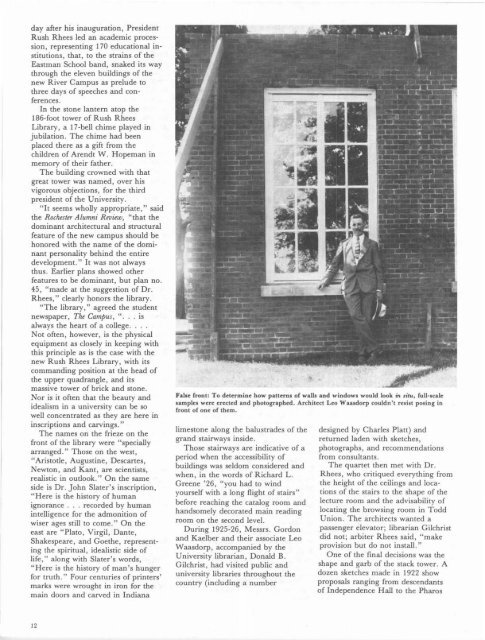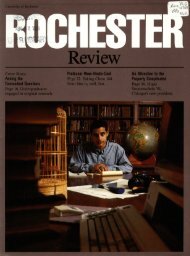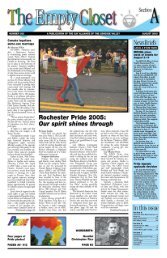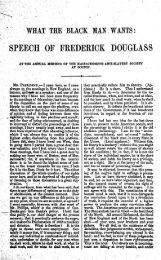Download PDF - University of Rochester Libraries
Download PDF - University of Rochester Libraries
Download PDF - University of Rochester Libraries
You also want an ePaper? Increase the reach of your titles
YUMPU automatically turns print PDFs into web optimized ePapers that Google loves.
day after his inauguration, President<br />
Rush Rhees led an academic procession,<br />
representing 170 educational institutions,<br />
that, to the strains <strong>of</strong> the<br />
Eastman School band, snaked its way<br />
through the eleven buildings <strong>of</strong> the<br />
new River Campus as prelude to<br />
three days <strong>of</strong> speeches and conferences.<br />
In the stone lantern atop the<br />
186-foot tower <strong>of</strong> Rush Rhees<br />
Library, a 17-bell chime played in<br />
jubilation. The chime had been<br />
placed there as a gift from the<br />
children <strong>of</strong> Arendt W. Hopeman in<br />
memory <strong>of</strong> their father.<br />
The building crowned with that<br />
great tower was named, over his<br />
vigorous objections, for the third<br />
president <strong>of</strong> the <strong>University</strong>.<br />
"It seems wholly appropriate," said<br />
the <strong>Rochester</strong> Alumni Review, "that the<br />
dominant architectural and structural<br />
feature <strong>of</strong> the new campus should be<br />
honored with the name <strong>of</strong> the dominant<br />
personality behind the entire<br />
development." It was not always<br />
thus. Earlier plans showed other<br />
features to be dominant, but plan no.<br />
45, "made at the suggestion <strong>of</strong> Dr.<br />
Rhees," clearly honors the library.<br />
"The library," agreed the student<br />
newspaper, The Campus, ". . . is<br />
always the heart <strong>of</strong> a college....<br />
Not <strong>of</strong>ten, however, is the physical<br />
equipment as closely in keeping with<br />
this principle as is the case with the<br />
new Rush Rhees Library, with its<br />
commanding position at the head <strong>of</strong><br />
the upper quadrangle, and its<br />
massive tower <strong>of</strong> brick and stone.<br />
Nor is it <strong>of</strong>ten that the beauty and<br />
idealism in a university can be so<br />
well concentrated as they are here in<br />
inscriptions and carvings."<br />
The names on the frieze on the<br />
front <strong>of</strong> the library were "specially<br />
arranged." Those on the west,<br />
"Aristotle, Augustine, Descartes,<br />
Newton, and Kant, are scientists,<br />
realistic in outlook." On the same<br />
side is Dr. John Slater's inscription,<br />
"Here is the history <strong>of</strong> human<br />
ignorance . . . recorded by human<br />
intelligence for the admonition <strong>of</strong><br />
wiser ages still to come." On the<br />
east are "Plato, Virgil, Dante,<br />
Shakespeare, and Goethe, representing<br />
the spiritual, idealistic side <strong>of</strong><br />
life," along with Slater's words,<br />
"Here is the history <strong>of</strong> man's hunger<br />
for truth." Four centuries <strong>of</strong> printers'<br />
marks were wrought in iron for the<br />
main doors and carved in Indiana<br />
12<br />
False front: To determine how patterns <strong>of</strong> walls and windows would look in situ, full-scale<br />
samples were erected and photographed. Architect Leo Waasdorp couldn't resist posing in<br />
front <strong>of</strong> one <strong>of</strong> them.<br />
limestone along the balustrades <strong>of</strong> the<br />
grand stairways inside.<br />
Those stairways are indicative <strong>of</strong> a<br />
period when the accessibility <strong>of</strong><br />
buildings was seldom considered and<br />
when, in the words <strong>of</strong> Richard L.<br />
Greene '26, "you had to wind<br />
yourself with a long flight <strong>of</strong> stairs"<br />
before reaching the catalog room and<br />
handsomely decorated main reading<br />
room on the second level.<br />
During 1925-26, Messrs. Gordon<br />
and Kaelber and their associate Leo<br />
Waasdorp, accompanied by the<br />
<strong>University</strong> librarian, Donald B.<br />
Gilchrist, had visited public and<br />
university libraries throughout the<br />
country (including a number<br />
designed by Charles Platt) and<br />
returned laden with sketches,<br />
photographs, and recommendations<br />
from consultants.<br />
The quartet then met with Dr.<br />
Rhees, who critiqued everything from<br />
the height <strong>of</strong> the ceilings and locations<br />
<strong>of</strong> the stairs to the shape <strong>of</strong> the<br />
lecture room and the advisability <strong>of</strong><br />
locating the browsing room in Todd<br />
Union. The architects wanted a<br />
passenger elevator; librarian Gilchrist<br />
did not; arbiter Rhees said, "make<br />
provision but do not install."<br />
One <strong>of</strong> the final decisions was the<br />
shape and garb <strong>of</strong> the stack tower. A<br />
dozen sketches made in 1922 show<br />
proposals ranging from descendants<br />
<strong>of</strong> Independence Hall to the Pharos
















